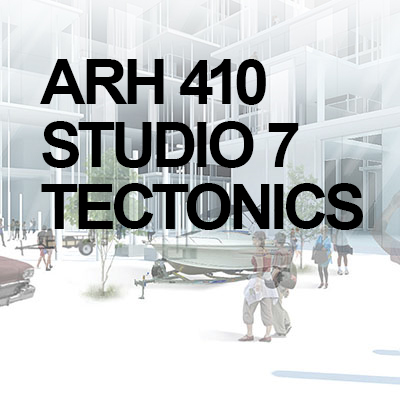
ARH 410 Studio 7 Tectonics and Structure
Architecture is a reflection of contemporary culture and conflict invites innovation. You will question preconceptions to find outdated modes of inhabiting space and discover new program relationships, spatial conditions, and rich tectonic expressions. You must take this course concurrently with ARH 420.
Prerequisites: ARH 320, ARH 330, ARH 350, ARH 420 (ARH 420 must be concurrent)
Course Learning Outcomes
- Develop design criteria using an iterative process and incorporate Technical Advisor feedback.
- Translate architectural intent into a building organization synthesizing site, program, circulation, materiality considerations into a formal language.
- Visualize and interpret relationships observed in the site context through generative and iterative mapping.
- Analyze environmental impact of design proposals and develop criteria for building orientation, massing, materials.
- Propose program appropriate for the building type based on a critical and ethical evaluation of user needs at the site.
- Develop interstitial spaces to find new program relationships and new modes of inhabiting space.
- Critique the building typology for its limitations through critical analyses of precedents with relevant architectural, structural, urban conditions suggestive of new interpretations.
- Develop a structural system integrated with architecture that considers the spatial qualities by using load path diagrams as a tool and thickness, density, materiality as variables.
- Develop a building envelope system with a tectonic response appropriate for the site and program through the use of spatial skin.
- Draft architectural drawings using correct drawing conventions to communicate design intent and the integration of architectural formal logic with structural design.
- Provide an accessible path of travel from the sidewalk to all occupied areas in an equitable manner.
- Provide egress with two means of exit from all occupied floors, exit stairs separated by the required minimum distance, doors swinging in the direction of exit travel, and no dead-end corridors.
NAAB Criteria
- PC 2 Design How the program instills in students the role of the design process in shaping the built environment and conveys the methods by which design processes integrate multiple factors, in different settings and scales of development, from buildings to cities.
- PC 8 Social Equity and Inclusion How the program furthers and deepens students’ understanding of diverse cultural and social contexts and helps them translate that understanding into built environments that equitably support and include people of different backgrounds, resources, and abilities.
- SC 5 Design Synthesis (Ability) How the program ensures that students develop the ability to make design decisions within architectural projects while demonstrating synthesis of user requirements, regulatory requirements, site conditions, and accessible design, and consideration of the measurable environmental impacts of their design decisions.
- Design: Architects design better, safer, more equitable, resilient, and sustainable built environments. Design thinking and integrated design solutions are hallmarks of architecture education, the discipline, and the profession.
Student Project by Juke Jose
Design Statement
Growing up in Manila, Balikbayan Boxes were sent from the United States by my family back to the Philippines filled with goods and the American dream. The boxes are manifestation of the “coming home” of the Filipino diaspora and the actualization of our dreams. The Wayfinding is a place that guides immigrants to achieve their American dreams, where new homes and relationships are anchored into the backbone of the United States forging evolving identities. It’s a space that creates a platform for immigrants where they can get support from the formal immigration process to learning languages, cultures, employment while establishing personal relationships and integrating to the communities of San Francisco. Through the use of a patchwork of spaces throughout the building, the immigration process of assembling a new way of life is reflected. The language of layered transparency across the spatial patchwork provides personal and visual connections between spaces. Curved planes generate intimate spaces carved out from the layers while embracing and leading users as they meander through the building.
Student Project by Kathleen Agonoy
Student Project by Zoe Zheng
Architecture is a reflection of contemporary culture. You will question preconceptions to find outdated modes of inhabiting space and discover new program relationships, spatial conditions, and rich tectonic expressions. You must take this course concurrently with ARH 420.
This course posits new ways to inhabit large urban structures through a process-driven methodology. By challenging type-driven formulaic structural responses, conflicts between architectural priorities and structural efficiencies are celebrated as the starting point of a dialogue that instigates structural adaptations creating rich tectonic expressions, complex spatial configurations, new program relationships.
When structural design lacks integration with architecture, the structural design criteria become largely dependent on efficiencies in cost and construction. The studio projects reinforce the concept of an efficiency that encourages resiliency through tectonic adaptation. This efficiency is understood to exist within a much longer time frame where the expression of the building is both integrative and timeless.
If we posit that architecture is to fulfill a need beyond structural stability and cost-effectiveness in construction, then the integration between architecture and structure points towards a different relationship in which the two disciplines engage in a dialogue. Founded on critical analyses of prevalent formulaic structural solutions, a productive dialogue is one in which there are meaningful conflicts that must be resolved. The students identify sources of conflict in order to develop an adaptable structural system. The metric by which resilience is measured is informed by the degree to which the integration between architecture and structure is successful in creating a trigger for a rich tectonic expression that adapts to conditions and needs while at the same time fulfilling the responsibilities of structural stability and efficiency.
